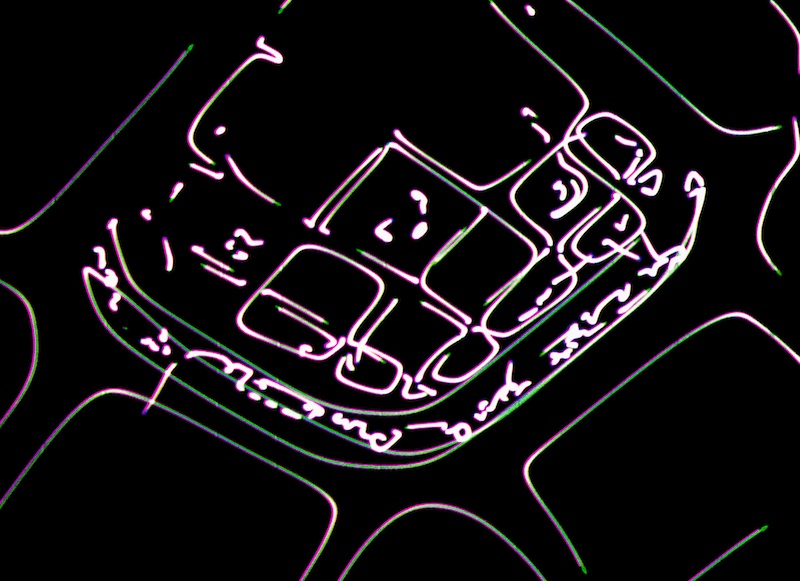…of the trace
…of the trace is an installation that intervenes in public space. It makes use of a laser steering system similar to the one in The Fine Tuning, however instead of being fed pure signals from electronic oscillators, it traces salient features of some architectural element in public space. A video camera is pointed at an architectural element in front of which passers-by walk to their respective destinations. A computer running custom software analyses these images and converts them into contours and lines which abstractly relate the architectural shapes to the motion of the passers-by, drawing lines and triangulations between them. These lines are then converted to voltages (control-signals) and routed to the laser-steering galvanometers and blanking mechanism, and thus traces these lines back onto the architecture. As with The Fine Tuning, these signals are also amplified and routed to speakers to provide a synesthetic effect. At some moments, the system plays back the motion of other passers-by, at others it behaves in real-time.
The work is inspired by thoughts on the banality of the trace in our contemporary culture, on the ease and imperceptibility with which bodies and their movements are indexed in the architecture of knowledge, which in turn constrains and structures our social behavioral patterns.
Interview with Ben Burnett of [HERE] MAGAZINE
[HERE]: When and how did you start making art?
Alexander Wilson: I’ve been producing media works for about 12 years, performance and theatre for about 7 or 8 years, and I’ve been making music in various forms since I was a teenager. In the past few years have I been finding ways to integrate all of my aesthetic influences and interests. I think one of the things that got me into art was its ritualistic aspect, the way it creates a space and time of criticality and reflexion. I always loved the subtlety of the questions being posed in art, as though art was specifically geared to problematizing those more abstract realities we deal with, that cannot be treated with quantities and scientific reductions. Art, for me, is essentially a concern with sensation, affect, and in a certain way contingency, accident, eventfulness.
[HERE]: What is the message behind …of the trace? Can you give a rundown of the idea behind the exhibit?
Alexander Wilson: I’d rather not think of the work as having a “message”. I try to distance it from my intentions. Desubjectivise. I try to have the work emerge from the process. Its initial ideas come from observations of today’s hypermedia society, where everyone is walking around with TV broadcasting stations in their pockets. More than ever, our day to day behaviours are leaving traces behind in a kind of super-organismic meta-memory: our thoughts and actions are constantly being uploaded and immediately indexed for future retrieval. The “PRISM” affair is a timely example. But we are all participating in this indexing of what used to be spontaneous and provisional gestures into this global hypomnemton, where they become crystallized in history. There has emerged a certain “banality of the trace” in the same sense as Hannah Arendt wrote of the “banality of evil”. We have become accustomed to being recorded, indexed, google-searched. Cyber-bullying is another example. However, with …of the trace, this idea is a starting point. I then try to create a kind evocative microcosm for it. A laser system scans the surrounding architectural features of the space, tracing lines that conform to the movements and bodies of the people in the room. (Visitor’s bodies and gestures are captured with a video camera. Custom software extracts their outlines and morphs them with the outlines of the architecture. These lines are then traced back onto the architecture with a laser scanner. The algorithm accumulates and replays the visitor’s motions at some moments. At other moments the reactivity happens in real-time. It is hence very sight specific, since every space will give a very different result.)
[HERE]: Your exhibits are so indebted to the work of sound and specifically sound in a place, where do you draw your influence for these public displays of sound?
Alexander Wilson: Though …of the trace might has some elements in common with the digital minimalism of audiovisual artists like Carsten Nicolai and Ryoji Ikeda, I am much less formalist in my approach. My involvement in performance with Parabolik Guerilla and in electronic music improv with, for example, K.A.N.T.N.A.G.A.N.O., feeds an element of provisionality into my audiovisual works. I want the installation to keep some of the rawness and spontaneity I find in the experimental music and performance art scenes, which are less contrived than many currents in the new media. The images produced here are more organic than geometric, and the over-all feel is more analogue-like. The synesthetic use of audio signals to drive a laser-steering mechanism will remind some of Robin Fox’s or Edwin van der Heide’s shows, and to some of my own performances (The Fine Tuning). But in this piece, the audio signals driving the laser are made to conform with the architecture. So in a way, the image drives the sound, which in turn drives the image. The noise visitors will hear in the installation is the actual signal used to trace the lines.
